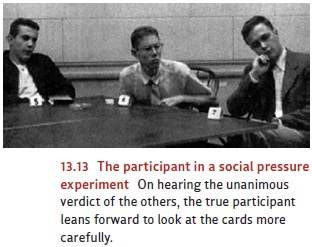Chapter: Psychology: Social Psychology
Social Influence: Conformity

Conformity
People
often do what they see others do. Sometimes this is a good thing, such as when
people cross at the crosswalk, throw their trash in garbage cans, or drive on
the side of the road they are supposed to. However, people’s propensity to do
as others do can also be a bad thing, as when people litter or even steal when
they see that others are failing to behave appropriately (Keizer, Lindenberg,
& Steg, 2008). Confirmity occurs
when-ever people change their behavior because of social pressure (either
explicit or implicit).
One
early demonstration of conformity comes from a classic study by Sherif (1937).
In this study, participants seated in a dark room saw a point of light appear,
move, and then disappear. This happened a number of times, and the
participants’ task was sim-ply to judge how far the light had moved on each
trial. In reality, however, the light never moved, and the appearance of
movement was the result of a perceptual illusion known as the autokinetic
effect.
When
participants made their judgments alone, their responses differed
substan-tially from one person to the next, ranging from an inch to more than a
foot. Participants’ responses also varied considerably from trial to trial.
When participants viewed the light with one or two other people, however, their
responses quickly began to converge with those of the other members of their
group. Different groups converged upon different answers, but in each case the
participants rarely strayed from the norm that had developed in their
particular group.
Most
telling, perhaps, was what Sherif found when he placed a confederate into the
situation, someone who appeared to be a participant, but who in reality was an
accom-plice of the experimenters. When the confederate made responses that were
much lower than those typically made by solitary participants, the other (real)
participants quickly followed suit, and a group norm emerged that was much
lower than normal. Similarly, when the confederate made responses that were
much higher than typical, the others again followed this lead, and the
resulting group norm was much higher than usual.
Sherif ’s findings are provocative because they suggest that others can influence even our basic perceptions of the world. Note, though, that Sherif had concocted a highly ambiguous situation in which participants were literally groping in the dark for an answer. Do people conform even when the correct answer is obvious?
Solomon
Asch developed a procedure in which there could be no doubt as to the cor-rect
response (Asch, 1951, 1952, 1955, 1956). In his experiments, Asch brought
groups of people into the laboratory and showed them pairs of cards, placed a
few feet away (Figure 13.12). On one card was a black line, say, 8 inches long.
On the other card were three lines of varying lengths, say, 6, 8, and 7 inches.
The participants were asked sim-ply to pick which of the three lines on the one
card was equal in length to the single line on the other card.

The
three lines were clearly different, and one of them exactly matched the
origi-nal line, so the task was absurdly simple. But there was a catch. There
was actually only one real participant. All of the others were confederates,
with their seats arranged so that most of them would call out their judgments
before the real partici-pant had his turn.
In
the first few trials, the confederates each called out the correct response and
the real participant did the same. After the initial trials, however, the
confederates began to unanimously render false judgments on most of the
trials—declaring, for example, that a 6-inch line equaled an 8-inch line, and
so on (Figure 13.13). In this situation, the clear evidence of the
participant’s senses was contradicted by everyone around him, so what should he
do? Asch found that most participants wavered—sometimes offering the correct
response but on many other trials yielding to the obviously mistaken suggestion
offered by the group. Indeed, the chances were less than one in four that the
participant would be fully independent and would stick to his guns on all trials
on which the group disagreed with him (for an analysis that highlights the
striking independence of some participants, see Friend, Rafferty, & Bramel,
1990).

THE CAUSES OF CONFORMITY
Why
do people conform—in Asch’s studies, and in many other settings (Figure 13.14)?
Two influences appear to be crucial (M. Deutsch & Gerard, 1955).

The
first—known as informational influence—involves
people’s desire to be right (Cialdini & Goldstein, 2004). Researchers have
demonstrated the role of this sort of influence by altering the Asch-type
experiment to make discriminating among the line segments very difficult. In
this setting, we might expect people to be confused about the correct answer,
and therefore more likely to seek out other cues for how they should respond.
Plausibly, they might listen more to what others say—leading to the predic-tion
that with more difficult discriminations, more social conformity will occur.
This prediction is correct (Crutchfield, 1955). Conversely, we can alter the
situation so that participants have less
reason to listen to others (e.g., by convincing participants they are more
competent or knowledgeable than others in some domain). In this case, we would
expect the participants to rely less on the others’ views, and so we would
predict less conformity. This prediction also is correct (Campbell, Tesser,
& Fairey, 1986; Wiesenthal, Endler, Coward, & Edwards, 1976).
This line of reasoning helps to explain why, in general, people seek the opinion of others when they encounter a situation that they do not fully understand. To evaluate the situation, they need more information. If they cannot get it firsthand, they will ask others, and if that is not an option, then they can try to gain information by comparing their own reactions to those of others (Festinger, 1954; Suls & Miller, 1977). This pat-tern of relying on others in the face of uncertainty can also be observed in young children, and even in infants. Infants who confront a scary situation and do not know whether to advance or retreat will glance toward their caretaker’s face. If she smiles, the infant will tend to advance; if she frowns, he will tend to withdraw and return to her. This early phenomenon of socialreferencing may be the prototype for what happens all our lives, a general process ofvalidating our reactions by checking on how others are behaving.
Another
aspect of informational influence is that the decisions of other people can
shape the information we receive, and this, too, can lead to conformity.
Suppose you’re trying to decide what type of car to buy. If two of your
neighbors have purchased Toyotas, you’ll have a chance to observe these cars
closely and learn about their attrib-utes. In this way, your neighbors’
selection will bias the information available and may lead you to follow their
lead when you choose your own car (Denrell, 2008).
A
second reason for going along with the crowd—known as normative influence— revolves around people’s desire to be liked, or
at least not to appear foolish (B. Hodges & Geyer, 2006). Consider the
original Asch study in which a unanimous majority made an obviously incorrect
judgment. In this context, the participant likely saw the world much as it is,
but he had every reason to believe that the others saw it differently. If he
now said what he believed, he could not help but be embarrassed; the others
would probably think that he was a fool and might laugh at him. Under the
circumstances, the participant would prefer to disguise what he really believed
and go along, preferring to be “normal” rather than correct.
Direct evidence for the role of embarrassment as a normative influence comes from a variant of the Asch experiment in which the participant entered the room while the experiment was already in progress. The experimenter told her that since she arrived late, it would be simpler for her to write down her answers rather than to announce them out loud. Under these circumstances, there was little conformity. The lines being judged were of the original unambiguous sort (e.g., 8 inches vs. 6 inches in height), so that there was no informational pressure toward conformity. Since the judgments were made in private (no one else knew what she had written down), there was no (or little) motivational pressure either. As a result, participants showed a great deal of independ-ence (Asch, 1952).
MINORITY INFLUENCE
Asch’s
studies tell us that a unanimous majority exerts a powerful effect that makes
it difficult for any individual to stray from the majority ’s position. What
happens, though, when the individual is no longer alone? In one variation of
his experiment, Asch had one of the confederates act as the participant’s ally;
all of the other con-federates gave wrong answers, while the ally ’s judgments
were correct. Under these conditions, the pressure to conform largely
evaporated, and the participant yielded rarely and was not particularly upset
by the odd judgment offered by (the majority of ) the confederates.
Was
the pressure to conform reduced because the ally shared the participant’s
views? Or was it merely because the consensus was broken, so that the
participant was no longer alone in questioning the majority view? To find out,
Asch conducted a variation of the study in which a confederate again deviated
from the other confederates, but did not do so by giving the correct answer. On
the contrary, she gave an answer even farther from the truth than the group’s.
Thus, on a trial in which the correct answer was 6 1/4 inches and
the majority answer was 6 3/4 inches, the confederate’s answer might
be 8 inches. This response did not sup-port the participant’s perception (or
reflect the truth!), but it helped to liberate him even so. The participant now
yielded much less than when he was confronted by a unanimous majority. What
evidently mattered was the group’s unanimity; once this was broken, the
par-ticipant felt that he could speak up without fear of embarrassment (Asch,
1952). Similar studies have been performed in other laborato-ries with similar
results (V. L. Allen, 1975; V. L. Allen & Levine, 1971; Nemeth &
Chiles, 1988). The power of even a lone dissident sug-gests that totalitarian
systems have good reason to stifle dissent of any kind. The moment one
dissident voice is raised, unanimity is broken, and then others may (and often
do) find the courage to express their own dissent (Figure 13.15).

CULTURE
AND
CONFORMITY
Asch’s
studies of conformity and most others like it were conducted on participants
from an individualistic society, the United States. Many of these participants
did conform but experienced enormous discomfort as a result, plainly suffering
from the contrast between their own perceptions and the perceptions of others.
The pattern is different in collectivistic cultures. Here individuals are less
distressed about conform-ing even when it means being wrong. Over two dozen
Asch-type conformity studies have now been conducted in collectivistic
cultures, and they support such a conclusion (Bond & Smith, 1996).
Members of collectivistic and individualistic societies tend to differ in other ways too. Consider the group pressure that presumably led to conformity in Asch’s experi-ments. On the face of it, one might expect collectivists to be more sensitive to this pres-sure, and so to endorse the group’s judgments more often than do individualists. But it turns out that for collectivists, the likelihood of conformity depends on the nature of the group. Collectivists are more likely to conform with members of a group to which they are tied by traditional bonds—their family (including extended family), class-mates, close friends, and fellow workers. In contrast, they are less affected than are indi-vidualists by people with whom they do not share close interpersonal bonds (Moghaddam, 1998).
Related Topics